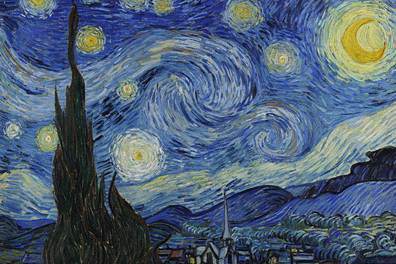...and Our Importance on the Pale Blue Dot
|
Most of you know that my educational background is in philosophy, history, the arts, and liberal arts in general. However, I think that I have some scientific abilities. Hey, I had 10-hours of geology in my freshmen year, which was 50-years ago. In addition, I read a lot and enjoy reading about our evolution as a universe circa 13.82-billions of years ago. In addition, I watched all of the Cosmos series in 1980 and the updated one that started airing several weeks ago. Therefore, allow me give you some thoughts about our cosmic calendar that dates back nearly 14-billion years. Both the Cosmos series addressed the issue of the cosmic calendar. However, they did not spell out my thoughts about that calendar and us as humans in the vast cosmos. Why Neil deGrasse Tyson or at least one of the program's producers did not think about asking me for my thoughts, I do not know. However, you will have the benefit of my insights based upon my blending of science and the liberal arts. Let us begin with an explanation of the cosmic calendar. Unless you have taken geology at Muskingum College, which is now a university, you might find it difficult to wrap your mind around the time issue. Most nonscientific types can handle the notion of talking about 200,000-years, which just happens to be the estimated time that Homo sapiens, people like us, started to develop in Africa. There is one race of people, and that race emerged in Africa. If this is news to any of my readers, read The Seven Daughters of Eve by Bryan Sykes. He and those who followed his explanation have checked DNA from around the world and found that humans came from ironically around Kenya.
Therefore, the birthers are right about President Obama coming from Kenya. What they missed was that we all came from Africa. Some left Africa starting about 70,000-years ago. Okay, to be precise, all the people who live outside of Africa today were descendants of people who evolved from the area around what is called present-day Kenya. What we call today Europeans, Asians, South Americans, etc. were descendants of those who started to emerge out of Africa circa 70,000 years ago.
Nonetheless, 200,000 is a number, which most of us can handle and comprehend. If we attempt to grasp a greater amount of time, we have pushed our abilities beyond a usable point. Try thinking about 10-million years. That is difficult to fathom. However, attempting to wrap one's mind around 13.82-billion years is a bit beyond my semi-scientific mind...and probably most of yours also. Therefore, when both Cosmos programs broke it down for the masses, we all got it. Both Sagan and Tyson used the timespan since the Big Bang to the present as if it were a mere year. This tripartite chart visually shows what Sagan and Tyson explained on Cosmos. The first section of the cosmic calendar starts with January and goes to December. You will note important developments during the monthly cosmic calendar like the emergence of the Milky Way in May.
The second section of the chart consists of the month of December and the dating of major changes to our planet. For example, by mid-December, sponges and fish evolved. Dinosaurs appeared on what we call Christmas Day and became extinct in less than a week later on the December 30.
The month of December in the Cosmic Calendar The third section of the chart is the last minute of the entire year.
One minute on the Cosmic Calendar At the last 46 seconds, humans emerged as hunter-gathers. The agrarian/farming civilization began in the last 22-seconds of last minute of the year. Now, I do not want to argue about whether it was 22 or 21-seconds or whether Christ came in the last 5 or 4.5 seconds. Humans emerged in the last minute of the last day of the cosmic year.
This photo was taken by Voyager 1 We started to migrate out of Africa at 11:58 pm and a second later Neanderthals all died out. Therefore, as you read this article, you and your family will have been here less than an atomic part of a nanosecond. I want you to ponder how you or all humans fit into this snapshot of the 13.82-billion years since the Big Bang. We have been here for 200,000-years out of nearly 13.82-billion years. Are you feeling like a Johnny-come-extremely-lately person...in the last few second of the cosmic history? However, it also seems to me that humans put an anachronistic spin on it. We come into the cosmos in the last few seconds and view ourselves as the reason for the universe even though we are not the crème de la crème of all creation. Other hominid evolution has occurred over the past 5-6 million years. For example, Homo erectus were around for 2-million years, which is about 10-times longer than Homo sapiens have been around. Dinosaurs were around for over 230-million years while we have been around for 200,000-years. While many of us see humans as this crème de la crème of creation, we have a very doubtful future. Read Adam's Curse by Bryan Sykes. Sykes predicts that males will become extinct in 125,000-years if we do not destroy the earth by nuclear war or climate change prior to extinction.
Humans kill other humans for many reasons. Religion, politics, greed, racism, sexism, homophobia, jealously, etc. We picture ourselves as the king of the hill until someone else wants that to the king of the hill. Then the cycle continues ad infinitum. We need to see the cosmic calendar and get it. Maybe then, we will stop adding to the long list of stupid things that we do. We need to awaken and end our self-fulfilling prophecy about who we think we are.
And that is why Carl Sagan is a mentor of mine. The Scottish poet, Thomas Campbell, once wrote, "To live in hearts we leave behind is not to die." That is profoundly true. Carl Sagan is gone from our lives, but he does live on in our hearts and minds. A postscript to the Cosmic Calendar, read Carl Sagan's book, Pale Blue Dot.
Carl Sagan's book Pale Blue Dot This is a longer video of Carl Sagan's video of the Pale Blue Dot.
Visit the On Seeing the Light page to read more about this topic.
Visit The Mentors and Me page to read more about this topic.
Forrest Gump, "Stupid is as stupid does." Visit the Stupid is As Stupid Does page to read more about this topic. 05/15/14 Follow @mountain_and_me |



















